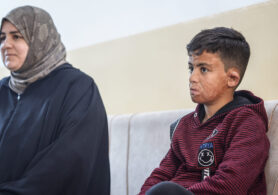On May 30, the Public International Law and Human Rights – Honours Programme Clinic at Utrecht University, directed by Jessica Dorsey, who is also the co-lead of the Realities of Algorithmic Warfare Project, hosted an impact event on ‘Transparency and Accountability in Military Operations’. The day was tightly packed with insightful inputs from the diverse and multidisciplinary range of panelists and speakers.
After a brief introduction to the day and the work of the Honours Law Clinic, the first panel, led by Machiko Kanetake, Assistant professor in International and European Law at Utrecht University, started with academic and civil society perspectives on transparency and accountability in the military domain. Aisha Dennis, Extrajudicial Executions Project Lead at the human rights NGO Reprieve, began by highlighting the need to center local and affected voices. A call that was echoed and amplified by Karolina MacLachlan, Senior Advisor at CIVIC. She promoted an understanding of accountability that goes beyond the legal level, focusing in particular on the commitment to change existing processes that triggered civilian harm in the first place. Developing a feedback loop is an important step in translating the accountability debate into meaningful change. Jessica Dorsey, Assistant Professor of International and European Law at Utrecht University, offered a more theoretical view on the intersection of legal, public, and ethical accountability and transparency through the conceptual lens of legitimacy, before concretizing it through the example of Dutch Defense doctrine. Floris Tan, Legal Officer in the Dutch Ministry of Foreign Affairs but speaking in his personal capacity, highlighted the importance of institutionalized investigations in the context of transparency and accountability and advocated for a stronger integration of formal transparency requirements in, e.g., International Humanitarian Law.
The interesting participant interventions were complemented by the subsequent discussion. A key topic was, among other things, the influence of unequal power relations on the limited transparency towards affected individuals. Local communities continue to have little opportunity to demand clarification and to access information after civilian harm incidents. An aspect, as Jessica Dorsey noted, that is exacerbated by the fact that the state’s executing violence do so increasingly from a remote distance, which further reduces interaction and understanding for on-the-ground circumstances. Another take-away from the discussion was the importance of reverberating civilian harm effects. Current transparency efforts revolve primarily around figures on civilian casualties and neglect other impacts, for example on injury, livelihood, environment, social fabrics, or gender, to name only a few that Aisha Dennis brought to the table. The Q&A with the audience led to further interesting insights into topics such as methods for civilian harm investigation, outsourcing of investigations, the perception of operationalized civilian harm mitigation in Western militaries, the role of state responsibility in accountability mechanisms and more. Dr. Lauren Gould highlighted that Brown University has recently published research reporting that 4.5 million people have died as a consequence of 20 years of the War on Terror carried out by Western advanced militaries. This underlines the extreme importance of making our militaries more transparent and accountable if we want to prevent the same staggering amount of deaths from occurring in the next 20 years.
The event continued with an inspiring keynote by Cedric Ryngaert, Professor of International and European Law at Utrecht University and Chair of the Dutch Advisory Committee on Public International Law (CAVV), who placed the two terms of interest in the context of military AI and autonomous weapon systems. The main result of the presented report of CAVV on the topic from 2015: investments in semi-autonomous (distinction from fully autonomous by maintaining human in the decision-making loop) are needed, but they must be regulated. Transparency and accountability must serve as key guidance in this process to limit the negative consequences of innovating and deploying these weapon systems.
The second panel of the day, led by Lauren Gould, Assistant Professor in Conflict Studies at Utrecht University and Project Lead of the Intimacies of Remote Warfare Program and the Realities of Algorithmic Warfare programme, dove a little deeper into what transparency and accountability mean within Dutch military operations. Emily Tripp, Director of Airwars, emphasized again that the right to transparency belongs first and foremost to the people affected. Building on this, Erin Bijl, Senior Project Officer in the Protection of Civilians Team at PAX, described how the notion of transparency today predominantly refers to democratic oversight in the intervening countries, leaving those victims on the receiving end unacknowledged, uninformed and frustrated – a structure that needs to be overcome. She also advocated for a cultural change in the transparency debate, away from blaming the military and towards constructive reform. A wish that was shared by Bob van Dijk, Policy Coordinator and Protection of Civilians Team Lead in the Dutch Ministry of Defense. He also highlighted the practical and security concerns in the context of operational transparency and data provision. Lastly, Lotte Kerkkamp-De Rijcke, Business Developer of military AI projects at TNO, described the highly contextual innovation and development process of military AI and the reflection of transparency and accountability therein. She also repeated the fact that AI should only be introduced to weapon systems if they can be trained with reliable data and deal with the complex and chaotic realities of war and should not be used nor developed if they cannot. She emphasized that we have a choice in this matter and that the innovation in AI is neither inevitable nor anything but an outcome of human agency.
In the discussion that followed, things became ever more concrete. Emily Tripp explained the methods Airwars uses and the importance of robust data sets and collaboration with media and academia. Bob van Dijk described the emergence and development of the MoD’s civilian harm policy in the wake of the releases and public debates around the Dutch involvement in Hawija and Mosul in 2015, highlighting the steps taken so far, but also acknowledging that there is much more to be done and that the process is sometimes sluggish. Often a place for more concrete work from the perspective of the MoD would be developing effective methods operationalizing some of the theoretical ideas coming from researchers and advocacy groups. Lotte Kerkkamp-De Rijcke outlined TNO’s focus with respect to developing responsible military AI applications but admitted that the ethics (and whose ethics) made these processes even more complex. She welcomed the transdisciplinary focus of the conference and believes this is the way forward in development, innovation and deployment of military AI technologies. The interesting questions during the Q&A revolved around terminology in the context of compensation, standards of proof, accountabilities in military coalitions and more.
The final hour of the conference was dedicated to a reflection panel on the day with all panelists and the audience. Jessica Dorsey moderated this and started with four interactive questions for the audience on what militaries ought to be transparent about regarding operations, the various types of accountability that should factor into the discussion, how transparency and accountability should be built into military AI applications and areas for future research/advocacy. These answers fed into a robust discussion regarding the day’s themes to round out the conference.
All in all, the event exposed diverse and in-depth perspectives on the topics of transparency and accountability in military operations. The valuable contributions and discussions will certainly resonate with all participants for some time to come and hopefully lead to continuous improvements in the handling and minimizing of civilian casualties and other, more indirect harm from military operations. This will only be possible, as became clear again and again during this day, if affected populations are heard, included, and informed and the realities of warfare became more apparent to all stakeholders to inform decision-making at all levels of society.
This review was written by IRW LAB student Laszlo Steinwärder.



